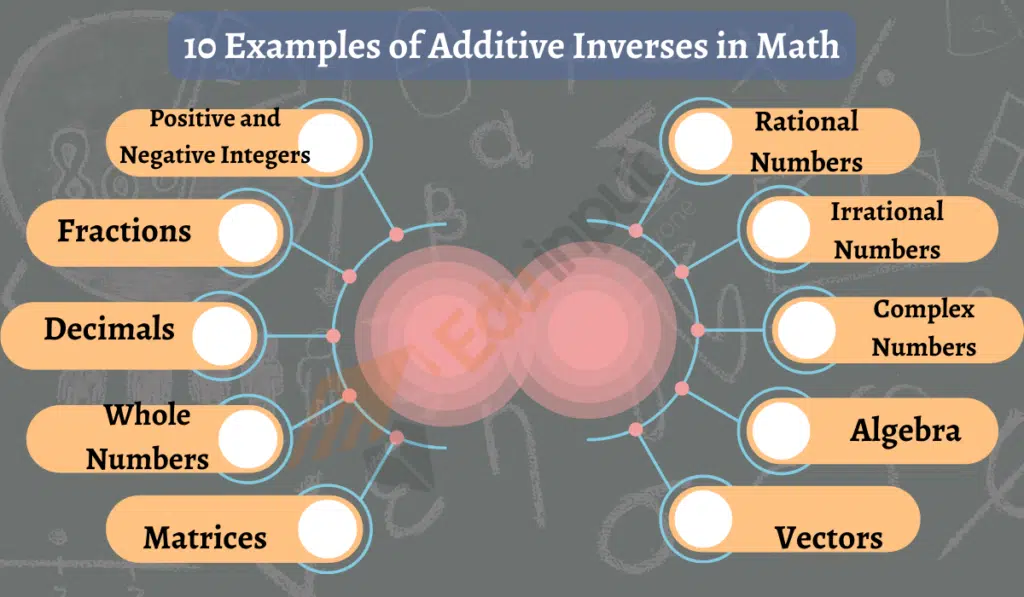10 Examples of Additive Inverses in Math
In the world of mathematics, additive inverses play a important role in understanding the fundamental properties of numbers and operations.
Additive inverses, which can also be called opposite numbers, are pairs of numbers that, when you add them, make zero. In general
a + (-a) = 0
To put it simply, if you have a number ‘a,’ its additive inverse is ‘-a.’ When you add ‘a’ and ‘-a’ together, the result is always zero.
In this article we will discuss the 10 Examples of Additive Inverses in Math.

Examples of Additive Inverse
1: Positive and Negative Integers
Let’s start with the most basic form of additive inverses: positive and negative integers. For any positive integer ‘a,’ its additive inverse is ‘-a.’ For instance, 5 and -5 are additive inverses, as 5 + (-5) equals zero.
2: Fractions
Additive inverses extend to fractions as well. If you have a fraction ‘a/b,’ its additive inverse is ‘-a/b.’ For example, the additive inverse of 3/4 is -3/4.
3: Decimals
Decimal numbers also follow the concept of additive inverses. Consider the number 2.5; its additive inverse is -2.5. When you add 2.5 and -2.5, you get 0.
4: Whole Numbers
Whole numbers, including zero, exhibit additive inverses too. For instance, the additive inverse of 8 is -8.
5: Rational Numbers
Rational numbers, which include integers and fractions, have additive inverses. Take 1/3, for example; its additive inverse is -1/3.
6: Irrational Numbers
Even irrational numbers, like the square root of 2, have additive inverses. The additive inverse of √2 is -√2.
7: Complex Numbers
Complex numbers, consisting of real and imaginary parts, also adhere to this concept. For instance, the additive inverse of 2 + 3i is -2 – 3i.
8: Variables and Algebra
In algebra, variables can have additive inverses too. If ‘x’ is a variable, its additive inverse is ‘-x.’
9: Matrices
In linear algebra, matrices can have additive inverses. When you add a matrix to its additive inverse, you get the zero matrix.
10: Vectors
In the world of vectors, additive inverses are critical. If you have a vector ‘v,’ its additive inverse is ‘-v.’ When you add ‘v’ and ‘-v,’ you get the zero vector.
Knowing about additive inverses is valuable in many areas of math. These ten examples have demonstrated that this concept applies to all kinds of numbers and math subjects. When you understand additive inverses, your math skills become much stronger, like building a solid foundation for a house.
FAQS
1. Can you provide more examples of additive inverses in real-life scenarios?
Additive inverses are often seen in financial transactions, where expenses are represented as negative values and income as positive values. When you calculate your net financial position, you are essentially finding the additive inverse of your expenses.
2. Are there any numbers that don’t have additive inverses?
Yes, numbers without additive inverses are typically found in abstract algebraic structures, such as non-commutative rings.
3. Can you explain why additive inverses are essential in linear algebra?
Additive inverses in linear algebra help define vector spaces and provide a foundation for understanding linear transformations and equations.
4. How can I use additive inverses in solving equations?
Additive inverses are useful when isolating variables or balancing equations. They allow you to add or subtract the same value to both sides of an equation, simplifying the solving process.
5. Where can I learn more about advanced mathematical concepts like additive inverses?
You can explore online courses, textbooks, or consult with a mathematics tutor to dive deeper into advanced mathematical topics like additive inverses.






Leave a Reply